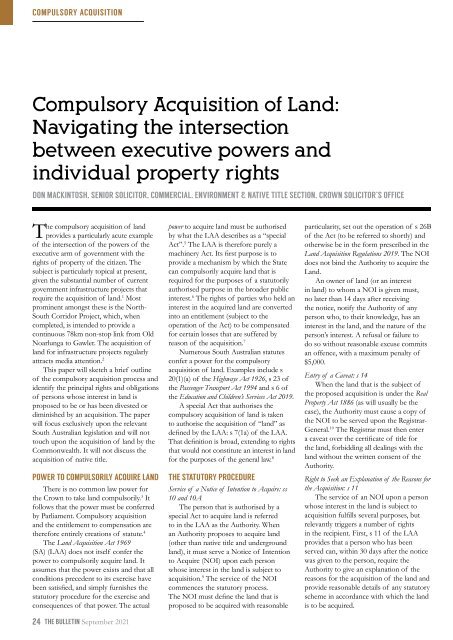LSB September 2021 LR
You also want an ePaper? Increase the reach of your titles
YUMPU automatically turns print PDFs into web optimized ePapers that Google loves.
COMPULSORY ACQUISITION<br />
Compulsory Acquisition of Land:<br />
Navigating the intersection<br />
between executive powers and<br />
individual property rights<br />
DON MACKINTOSH, SENIOR SOLICITOR, COMMERCIAL, ENVIRONMENT & NATIVE TITLE SECTION, CROWN SOLICITOR’S OFFICE<br />
The compulsory acquisition of land<br />
provides a particularly acute example<br />
of the intersection of the powers of the<br />
executive arm of government with the<br />
rights of property of the citizen. The<br />
subject is particularly topical at present,<br />
given the substantial number of current<br />
government infrastructure projects that<br />
require the acquisition of land. 1 Most<br />
prominent amongst these is the North-<br />
South Corridor Project, which, when<br />
completed, is intended to provide a<br />
continuous 78km non-stop link from Old<br />
Noarlunga to Gawler. The acquisition of<br />
land for infrastructure projects regularly<br />
attracts media attention. 2<br />
This paper will sketch a brief outline<br />
of the compulsory acquisition process and<br />
identify the principal rights and obligations<br />
of persons whose interest in land is<br />
proposed to be or has been divested or<br />
diminished by an acquisition. The paper<br />
will focus exclusively upon the relevant<br />
South Australian legislation and will not<br />
touch upon the acquisition of land by the<br />
Commonwealth. It will not discuss the<br />
acquisition of native title.<br />
POWER TO COMPULSORILY ACQUIRE LAND<br />
There is no common law power for<br />
the Crown to take land compulsorily. 3 It<br />
follows that the power must be conferred<br />
by Parliament. Compulsory acquisition<br />
and the entitlement to compensation are<br />
therefore entirely creations of statute. 4<br />
The Land Acquisition Act 1969<br />
(SA) (LAA) does not itself confer the<br />
power to compulsorily acquire land. It<br />
assumes that the power exists and that all<br />
conditions precedent to its exercise have<br />
been satisfied, and simply furnishes the<br />
statutory procedure for the exercise and<br />
consequences of that power. The actual<br />
24 THE BULLETIN <strong>September</strong> <strong>2021</strong><br />
power to acquire land must be authorised<br />
by what the LAA describes as a “special<br />
Act”. 5 The LAA is therefore purely a<br />
machinery Act. Its first purpose is to<br />
provide a mechanism by which the State<br />
can compulsorily acquire land that is<br />
required for the purposes of a statutorily<br />
authorised purpose in the broader public<br />
interest. 6 The rights of parties who held an<br />
interest in the acquired land are converted<br />
into an entitlement (subject to the<br />
operation of the Act) to be compensated<br />
for certain losses that are suffered by<br />
reason of the acquisition. 7<br />
Numerous South Australian statutes<br />
confer a power for the compulsory<br />
acquisition of land. Examples include s<br />
20(1)(a) of the Highways Act 1926, s 23 of<br />
the Passenger Transport Act 1994 and s 6 of<br />
the Education and Children’s Services Act 2019.<br />
A special Act that authorises the<br />
compulsory acquisition of land is taken<br />
to authorise the acquisition of “land” as<br />
defined by the LAA: s 7(1a) of the LAA.<br />
That definition is broad, extending to rights<br />
that would not constitute an interest in land<br />
for the purposes of the general law. 8<br />
THE STATUTORY PROCEDURE<br />
Service of a Notice of Intention to Acquire: ss<br />
10 and 10A<br />
The person that is authorised by a<br />
special Act to acquire land is referred<br />
to in the LAA as the Authority. When<br />
an Authority proposes to acquire land<br />
(other than native title and underground<br />
land), it must serve a Notice of Intention<br />
to Acquire (NOI) upon each person<br />
whose interest in the land is subject to<br />
acquisition. 9 The service of the NOI<br />
commences the statutory process.<br />
The NOI must define the land that is<br />
proposed to be acquired with reasonable<br />
particularity, set out the operation of s 26B<br />
of the Act (to be referred to shortly) and<br />
otherwise be in the form prescribed in the<br />
Land Acquisition Regulations 2019. The NOI<br />
does not bind the Authority to acquire the<br />
Land.<br />
An owner of land (or an interest<br />
in land) to whom a NOI is given must,<br />
no later than 14 days after receiving<br />
the notice, notify the Authority of any<br />
person who, to their knowledge, has an<br />
interest in the land, and the nature of the<br />
person’s interest. A refusal or failure to<br />
do so without reasonable excuse commits<br />
an offence, with a maximum penalty of<br />
$5,000.<br />
Entry of a Caveat: s 14<br />
When the land that is the subject of<br />
the proposed acquisition is under the Real<br />
Property Act 1886 (as will usually be the<br />
case), the Authority must cause a copy of<br />
the NOI to be served upon the Registrar-<br />
General. 10 The Registrar must then enter<br />
a caveat over the certificate of title for<br />
the land, forbidding all dealings with the<br />
land without the written consent of the<br />
Authority.<br />
Right to Seek an Explanation of the Reasons for<br />
the Acquisition: s 11<br />
The service of an NOI upon a person<br />
whose interest in the land is subject to<br />
acquisition fulfills several purposes, but<br />
relevantly triggers a number of rights<br />
in the recipient. First, s 11 of the LAA<br />
provides that a person who has been<br />
served can, within 30 days after the notice<br />
was given to the person, require the<br />
Authority to give an explanation of the<br />
reasons for the acquisition of the land and<br />
provide reasonable details of any statutory<br />
scheme in accordance with which the land<br />
is to be acquired.


















